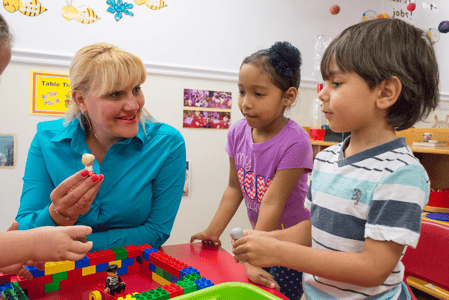
Concept Development and Quality of Feedback—these two CLASS dimensions used to elicit a sense of fear in me, and I suspect they do for other early childhood educators, too. The fear came from hearing the average teacher’s scores in these dimensions, confusing the two dimensions, and from knowing how important they are to impacting children’s cognitive development.
Well, fear can paralyze you and shut you down—or it can wake you up and get you moving. I chose to wake up and get moving by remembering the importance of these two dimensions and how to keep them straight.
Concept Development
This dimension focuses on the process of learning, how higher-order thought processes are promoted, and how much thinking is going on. When effective Concept Development is happening, teachers help children find answers themselves. Children are learning how to think (versus rote recall). In Concept Development, there are no wrong answers. Teachers guide children to make connections to what they’ve already learned, connect to the real world, and encourage children to understand and think!
Points to remember about Concept Development:
- Concept Development is initiated by the teacher.
- The depth and effectiveness of interactions are important to promoting higher order thinking.
- Concept Development is about thinking rather than memorization.
Quality of Feedback
Quality of Feedback is in response to what children say or do. It is the quality of the response (or feedback) that is given to children. In this dimension, teachers keep children thinking, keep children going, and keep children learning. When a teacher has effective Quality of Feedback, they promote learning without children feeling like they are being pushed. It is specific, in the moment, and encourages a child to learn more.
Points to remember about Quality of Feedback:
- Teachers provide effective feedback by asking follow-up questions and providing information in response to children‘s actions or comments.
- Teachers‘ high-level encouragement increases children’s understanding and persistence.
- Effective Quality of Feedback keeps children engaged in learning.
The depth and effectiveness of both Concept Development and Quality of Feedback prepare children for the learning they will have to do after they leave Pre-K. When teachers initiate higher-order thinking skills they set the stage for children to analyze, create, and solve problems. And teachers who provide effective feedback expand children’s learning, understanding, and participation! Isn’t that what matters?
Keep these key points in mind, and you too will keep these commonly confused dimensions straight! I’d love to hear how you remember the differences between Concept Development and Quality of Feedback. Share your comments below!
Editor's Note: This post was originally published in December 2015, but has since been revised to keep the content relevant and accurate.

